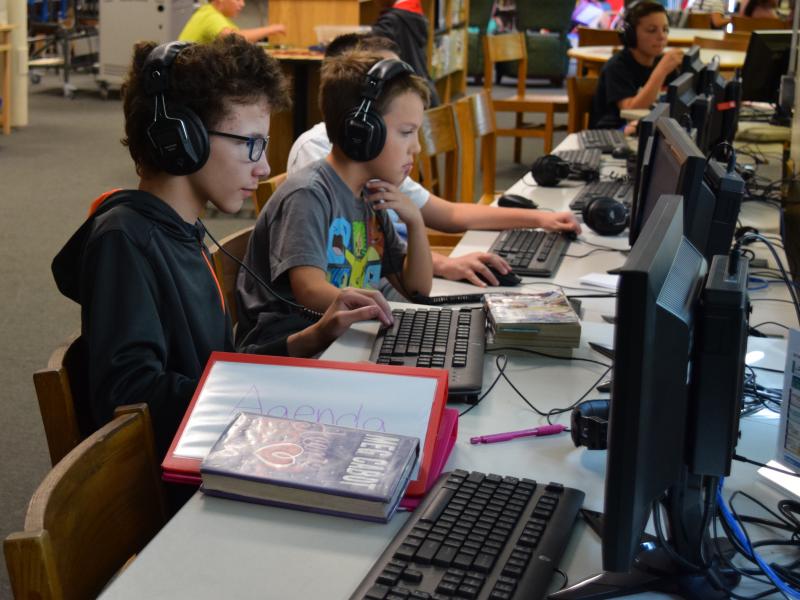Dartmouth schools upped technology usage. Here's what that looks like:
Dartmouth Public Schools are amplifying technology in the classroom to better prep students for the 21st century. Changes include hiring two full-time technology instructors, using Google office programs in elementary classrooms, and updating Wi-Fi speeds.
Potter Elementary School Principal Heidi Brooks welcomed Sandra Chicca as the school’s first full-time technology specialist, one of several changes made in accordance with Superintendent Bonny Gifford’s three-year strategic plan. Both Brooks and Chicca are working to add a new 30- to- 40-minute, weekly technology engagement class to the schedule, which will focus on prepping students for middle school.
“We want to create a curriculum for our students so that by the time they leave us after the fifth grade, they can transition to Dartmouth Middle School’s Google Classroom program,” Brooks said.
Middle-schoolers use the Google Classroom program to share files on Google Drive and to collaboratively write, edit, and track the revision history of documents via Google Docs, all while completing homework online.
Chicca will add grades 3-5 to the Google Classroom program. Individual teachers began implementing the program last year.
"It makes my job easier when the staff are on board with using new tools with the students," Chicca said via email. "It also allows for us to do so much more in the classroom."
Chicca has already started enhancing lessons with technology. During the first week of school, she showed students how to use an online dictionary to look up words they didn’t understand.
Susan Tullson teaches her students in the sixth grade English Language Arts Instruction Lab
“I am really looking forward to working with the students and staff at Potter,” Chicca said. “The technology is like second nature in the classroom, and that is so exciting.”
Brooks added that the school is also implementing a separate STEM block this year, which will give each grade level a dedicated time block to explore hands-on topics in science, technology, engineering, and mathematics.
On Dartmouth Street, DeMello and Cushman schools will be sharing new, full-time technology specialist Joshua Rodrigues. The tech instructor has already made headway at DeMello. The grades 1-5 school received Chromebook laptops and additional iPads at the beginning of the school year, he said, and Rodrigues will be working to make sure both teachers and students are comfortable using those tools.
“I can say from past experience you want to gauge where students and teachers are at,” Rodrigues said.
Rodrigues is also working to connect teachers and students to the Google Classroom program.
“What I’ve seen is [Google Classroom] takes the technology work out of teaching,” Rodrigues said. “It’s easy to set up and for teachers to access and use.”
Some of Rodrigues’ goals for the schools: he wants to implement a makerspace — a space dedicated to hands-on learning in making and building items, 3D modeling, and computer technology. He has also reached out to Dartmouth High School’s robotics teachers to help start a robotics club at DeMello; they will supply Lego robotics kits for the club.
“I want to build up our science and technology engagement,” Rodrigues said, explaining that he also has big plans for Computer Science Education Week, December 5-11. He hopes to run a special Hour of Code workshop, which challenges students to develop a computer program.
The elementary schools aren’t the only buildings getting upgrades. Dartmouth Middle School Assistant Principal Carl Robidoux highlighted several new changes this year, including adding more Chromebook laptops, and a new 3D printer in the library for students to learn 3D design.
The school is also experimenting with online textbooks, with all grade levels testing out digital science textbooks that can be accessed online and provides interactive features, such as looking up unfamiliar words.
Students in Justin Zexter's math class complete STAR testing on Chromebooks.
Robidoux added that the school purchased a new Scantron system — which electronically grades tests and compiles outcomes into a report including charts — halfway through the last academic year. The system allows teachers and administrators to immediately process test results, which helps teachers to better understand the effectiveness of classroom instruction.
Superintendent Bonny Gifford added that with the future of standardized testing becoming more computer-based, it is beneficial for the district to be able to have instant access to results.
“By putting kids on computers to take tests, reports are generated quickly so you can use the data,” Gifford said.
Districtwide, Dartmouth Public Schools Chief Technology Officer Jonathan Gallishaw is at the forefront of the ever-changing educational technology landscape. Gallishaw manages the school’s operational needs when it comes to technology, including networking infrastructure, wireless connectivity, and Internet speed.
Gallishaw has worked to overhaul the wireless networks at each school over the past few years. This year, staff worked at Dartmouth Middle School to bring faster and more reliable connectivity to each classroom. The district also hopes to double its Internet speed to provide faster access.
“Kids are streaming everything now,” Gallishaw said. “We need more bandwidth because all of the content is so rich.”
Eighth grade science teacher Amy Guile uses the smartboard in her classroom.
Gallishaw also meets schools’ educational needs, bringing hardware, software, and apps into the classrooms. This year, the district purchased 330 new Chromebook laptops — which were split up between the elementary schools and Dartmouth Middle School.
“My greatest challenge is keeping up with demand,” Gallishaw said. “Teachers and students want faster speeds and good content. They’re always demanding more.”
That demand also translates to the need for new products. Technology is always evolving, but new technology is often too expensive so the district waits for prices to drop, said Gallishaw.
For example, as the district is finishing up a project to supply the elementary and middle schools with Smartboards—electronic whiteboards with touchscreens and Internet connectivity—new Smartboards are already on the market that do away with overhead projectors and instead use large tablet-like screens. The district purchased one next-generation Smartboard to test out, but Gallishaw said they are too expensive to justify an upgrade.















